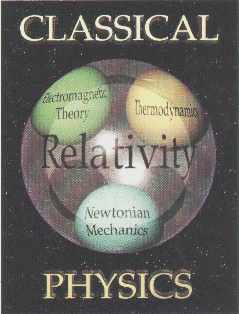
| Readings: |
Special Relativity |
Relativity:
Einstein's theory of relativity deals with Newtonian physics when energies or velocities are near the speed of light. Relativity is usually thought of as modern physics since it was developed at the start of the 20th century and could only be tested in the realm available to scientists by high technology. However, relativity primarily completes the revolution that Newton started and is also highly deterministic as is much of classical physics.

In the holistic viewpoint of relativity theory, concepts such as length, mass and time take on a much more nebulous aspect than they do in the apparently rigid reality of our everyday world. However, what relativity takes away with one hand, it gives back in the form of new and truly fundamental constants and concepts.
The theory of relativity is traditionally broken into two parts, special and general relativity. Special relativity provides a framework for translating physical events and laws into forms appropriate for any inertial frame of reference. General relativity addresses the problem of accelerated motion and gravity.
Special Theory of Relativity:
By the late 1800's, it was becoming obvious that there were some serious problems for Newtonian physics concerning the need for absolute space and time when referring to events or interactions (frames of reference). In particular, the newly formulated theory of electromagnetic waves required that light propagation occur in a medium (the waves had to be waves on something).
In a Newtonian Universe, there should be no difference in space or time regardless of where you are or how fast you are moving. In all places, a meter is a meter and a second is a second. And you should be able to travel as fast as you want, with enough acceleration (i.e. force).
In the 1890's, two physicists (Michelson and Morley) were attempting to measure the Earth's velocity around the Sun with respect to Newtonian Absolute space and time. This would also test how light waves propagated since all waves must move through a medium. For light, this hypothetical medium was called the aether.
The results of the Michelson-Morley experiment was that the velocity of light was constant regardless of how the experiment was tilted with respect to the Earth's motion. This implied that there was no aether and, thus, no absolute space. Thus, objects, or coordinate systems, moving with constant velocity (called inertial frames) were relative only to themselves.
In Newtonian mechanics, quantities such as speed and distance may be transformed from one frame of reference to another, provided that the frames are in uniform motion (i.e. not accelerating).
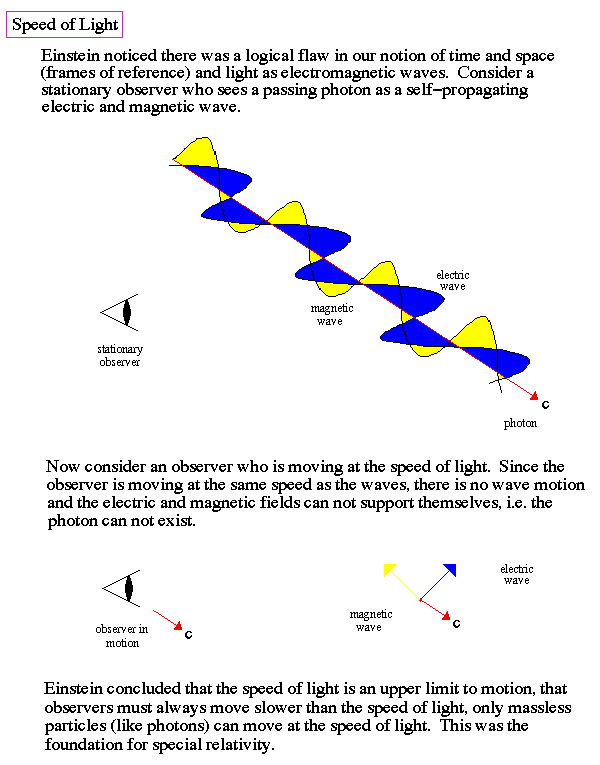
Considering the results of the Michelson-Morley experiment led Einstein to develop the theory of special relativity. The key premise to special relativity is that the speed of light (called c = 186,000 miles per sec) is constant in all frames of reference, regardless of their motion. What this means can be best demonstrated by the following scenario:
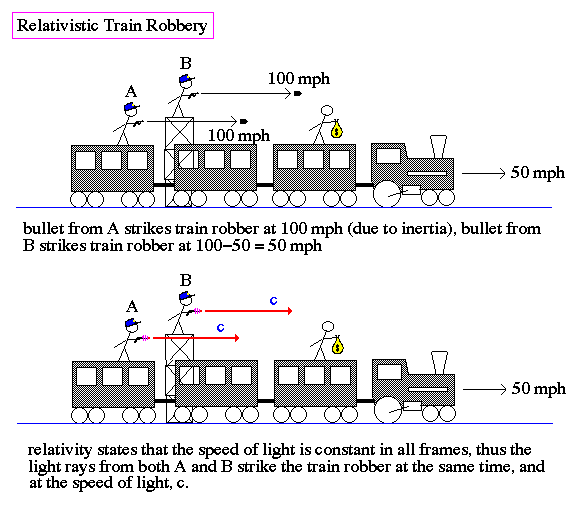
This eliminates the paradox with respect to Newtonian physics and electromagnetism of what does a light ray `look like' when the observer is moving at the speed of light. The solution is that only massless photons can move at the speed of light, and that matter must remain below the speed of light regardless of how much acceleration is applied.
In special relativity, there is a natural upper limit to velocity, the speed of light. And the speed of light the same in all directions with respect to any frame. A surprising result to the speed of light limit is that clocks can run at different rates, simply when they are traveling a different velocities.
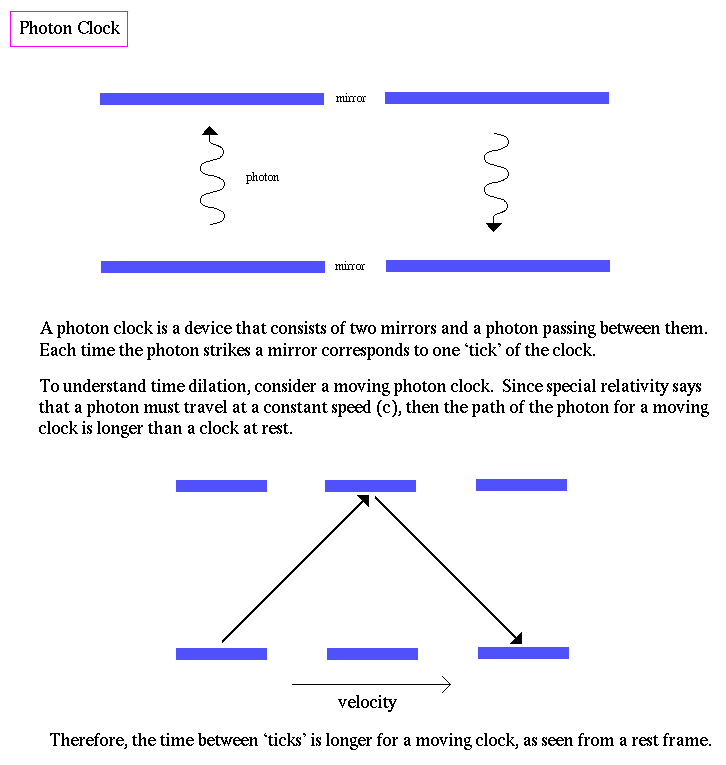
This means that time (and space) vary for frames of reference moving at different velocities with respect to each other. The change in time is called time dilation, where frames moving near the speed of light have slow clocks.
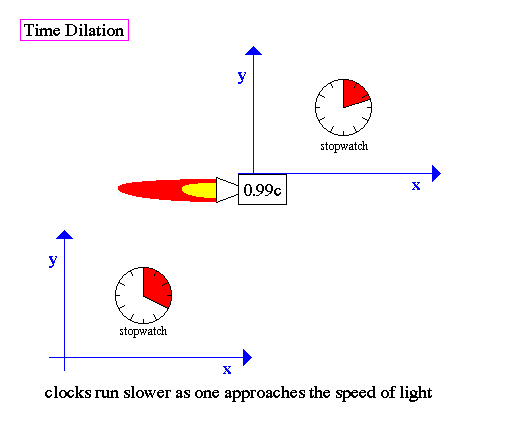
Likewise, space is shorten in in high velocity frames, which is called Lorentz contraction.
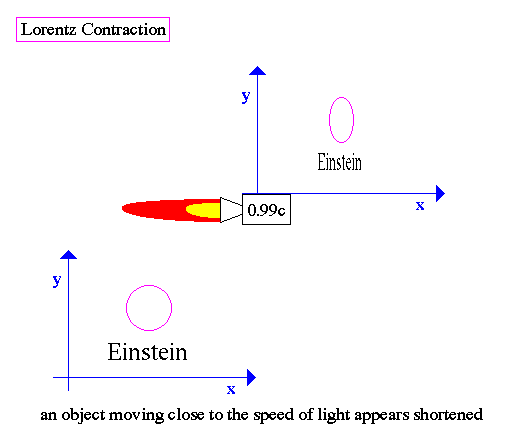
Time dilation leads to the famous Twins Paradox, which is not a paradox but rather a simple fact of special relativity. Since clocks run slower in frames of reference at high velocity, then one can imagine a scenario were twins age at different rates when separated at birth due to a trip to the stars.
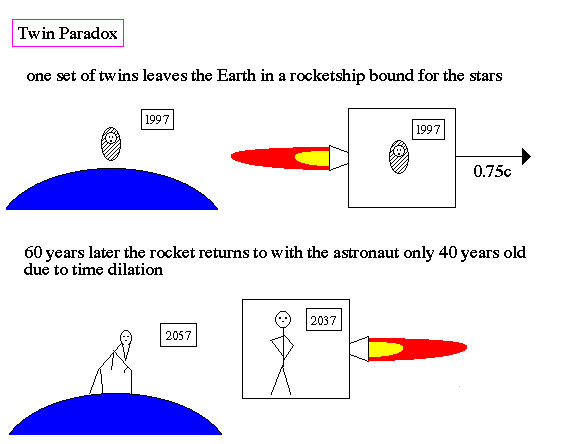
It is important to note that all the predictions of special relativity, length contraction, time dilation and the twin paradox, have been confirmed by direct experiments, mostly using sub-atomic particles in high energy accelerators. The effects of relativity are dramatic, but only when speeds approach the speed of light. At normal velocities, the changes to clocks and rulers are too small to be measured.
Spacetime:
Special relativity demonstrated that there is a relationship between spatial coordinates and temporal coordinates. That we can no longer reference where without some reference to when. Although time remains physically distinct from space, time and the three dimensional space coordinates are so intimately bound together in their properties that it only makes sense to describe them jointly as a four dimensional continuum.
Einstein introduced a new concept, that there is an inherent connection between geometry of the Universe and its temporal properties. The result is a four dimensional (three of space, one of time) continuum called spacetime which can best be demonstrated through the use of Minkowski diagrams and world lines.
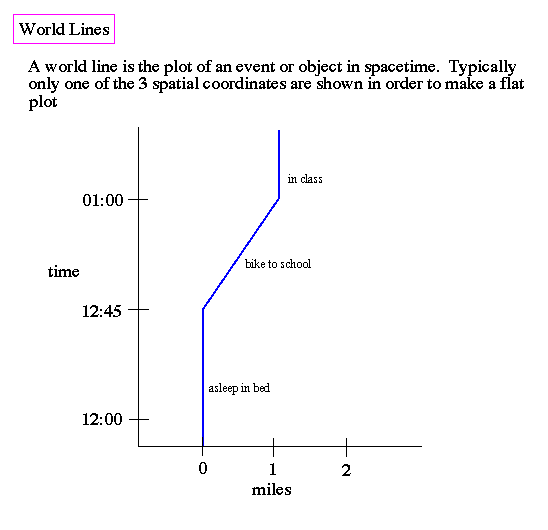
Spacetime makes sense from special relativity since it was shown that spatial coordinates (Lorentz contraction) and temporal coordinates (time dilation) vary between frames of reference. Notice that under spacetime, time does not `happen' as perceived by humans, but rather all time exists, stretched out like space in its entirety. Time is simply `there'.


|
|

|